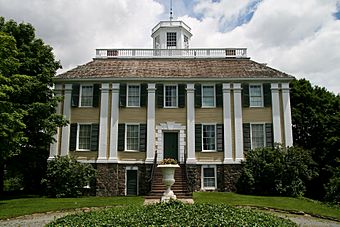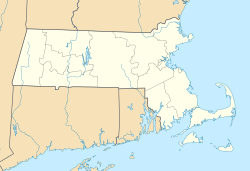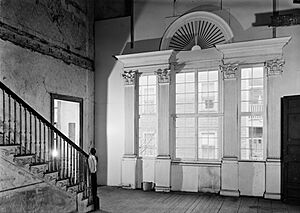Shirley–Eustis House facts for kids
|
Shirley–Eustis House
|
|
 |
|
| Location | 33 Shirley Street, Roxbury, Massachusetts |
|---|---|
| Area | .25-acre (0.10 ha) |
| Built | 1741 |
| Architect | Peter Harrison |
| Architectural style | Georgian |
| Website | shirleyeustishouse.org |
| NRHP reference No. | 66000787 |
Quick facts for kids Significant dates |
|
| Added to NRHP | October 15, Georgian |
| Designated NHL | October 9, 1960 |
The Shirley–Eustis House is a very old and important house located in Boston, Massachusetts. It's known as a National Historic Landmark, which means it's a special place recognized for its history. This beautiful house has stood for centuries and has many stories to tell about the people who lived there.
Contents
History of the Shirley–Eustis House
Building a Governor's Home
The Shirley–Eustis House was built a long time ago, between 1747 and 1751. It was constructed on a large piece of land in Roxbury, which is now part of Boston. The house was meant to be a summer home for William Shirley. He was the Royal Governor of the Province of Massachusetts Bay.
The design of the house is thought to be by a famous architect named Peter Harrison. It is one of only four mansions left in the United States that belonged to Royal Governors.
Early Owners and Important Figures
After Governor Shirley, his son-in-law, Eliakim Hutchinson, took over the house in 1763. Hutchinson was a very wealthy and important judge in Boston. Governor Shirley later moved back into the house with his daughter and son-in-law. He lived there until he passed away in 1771.
After Hutchinson died in 1775, the house was used by soldiers during the American Revolutionary War. It was later taken by the government because its owners were loyal to the British king. The house then sat empty for a while.
A Home for Many Families
In 1782, the house was bought again and had several different owners. One owner was the widow of a French planter. Another was a person who bought and sold land. Then, a wealthy merchant named James Magee bought it.
James Magee's youngest son, Augustus Magee, grew up in this house. He later became a leader in an important expedition in Texas in the early 1800s.
The Eustis Family and Later Years
Later, James Magee's widow sold the house to William Eustis. He was a very important person in American history. William Eustis served as the United States Secretary of War during the War of 1812. He was also an ambassador to the Netherlands and later became the first Democratic-Republican governor of Massachusetts.
After William Eustis's wife passed away in 1865, the house was sold by her relatives. In 1867, the large property was divided into many smaller lots and sold off. The mansion itself was also sold and moved about 60 feet to make room for a new street called Shirley Street. By 1886, many different families were living in the house. It was eventually left empty in 1911.
Saving the Historic House
A Plan to Preserve History
In 1913, a man named William Sumner Appleton stepped in to save the house. He had recently started a group called the Society for the Preservation of New England Antiquities. Appleton then created the Shirley–Eustis House Association. Their goal was to protect the house, which was being used to store old items at the time.
The house was officially recognized as a National Historic Landmark in 1960. This helped bring more attention to its importance.
Restoring the House and Gardens
In the 1980s, a historical architect named Robert G. Neiley and the Shirley Eustis House Association worked hard to save the old building, which was starting to fall apart. They began a big restoration project in the 1980s.
In 1991, the house finally opened to the public. The restoration work included bringing back the beautiful gardens. They planted an orchard, old-fashioned flower beds, and a large lawn. This amazing restoration project won an award for being the best-restored small building in Boston.
Today, the Shirley–Eustis House stands as a reminder of early American history. It teaches us about the lives of important people who shaped the country.
See also




